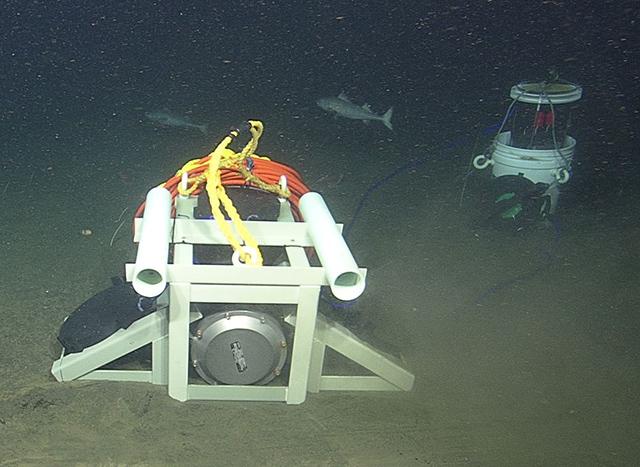MBARI Engineers Develop a New Low-Cost Way to Connect Deep-Sea Instruments
This image shows the Deep-Sea Connect system (foreground) and the Raspberry Shake seismometer (background) just before the instruments were connected to the MARS observatory. Image: © 2019 MBARI
Hoping to attract new users to MBARI’s MARS undersea observatory, MBARI engineers Craig Dawe and David French recently developed a wireless device called Deep-Sea Connect, a relatively inexpensive system for supplying data and power to instruments in the deep sea. In December 2019 they used this system to connect a low-budget seismometer to the MARS observatory.
The MARS observatory is connected to shore through a 52-kilometer (32-mile) seafloor cable that acts as a giant extension cord. At the end of this cable is a “science node” with eight ports that provide electrical power and a high-speed data connection between the observatory and instruments on the seafloor. Unfortunately, the waterproof power and data connectors used on MARS can cost up to $50,000 dollars each. This means that, historically, only well-funded researchers have been able to use the observatory.
Dawe and French developed Deep-Sea Connect to address this issue. Their hope is that the new system will allow additional researchers, and perhaps even school groups, to take advantage of the awesome potential of the MARS observatory.

This image shows the manipulator arm on ROV Ventana placing a wireless connector “paddle” from the Raspberry Shake on one of the paddles on the Deep-Sea Connect system. Image: © 2020 MBARI
Deep-Sea Connect consists of a small fiberglass frame with a titanium pressure housing that holds the “brains” of the system. On the sides and top of the frame are black plastic “paddles” that use radio waves to transmit power and data wirelessly underwater.
As an initial test for the system, the engineers hooked up a small, inexpensive seismometer called a “Raspberry Shake.” Based on the popular Raspberry Pi microprocessor boards, Raspberry Shakes can provide earthquake data comparable to that from professional short-period seismometers.
For their test deployment, the MBARI researchers packaged a Raspberry Shake inside a waterproof housing and added a wireless connector paddle to connect the unit to the main Deep-Sea Connect system.
After using remotely operated vehicle (ROV) Ventana to carry the instruments 900 meters (3,000 feet) down to the seafloor, the ROV pilots simply placed the paddle from Raspberry Shake on top of one of the paddles on the Deep-Sea Connect system and voila—data from the Raspberry Shake began flowing into the observatory network. Within a matter of hours, the data was visible on the Raspberry Shake website (https://raspberryshake.net/stationview/#?net=AM&sta=RDE9D). As Dawe noted, “There are over a thousand Raspberry Shake sites around the world, but ours is the only one in the water.”
How Deep-Sea Connect works
The Deep-Sea Connect system transfers data and power wirelessly using radio waves. In most cases, radio waves aren’t useful for communicating underwater because they don’t travel far through seawater. However, the paddles on Deep-Sea Connect are only about a centimeter apart, so high-frequency radio waves from one paddle can easily be detected in the other paddle.
For the initial deployment, the researchers packaged the Raspberry Shake inside a pressure housing that was previously used on one of MBARI’s underwater robots. They used a 3D printer to make the plastic paddles and bought an off-the-shelf wireless power transmitter. They embedded the power transmitter and a small Wi-Fi antenna in epoxy resin to protect them from the pressure of the deep sea. Engineers from the wireless power manufacturer, Wibotic, helped the MBARI researchers tune the electronics in the paddles to work efficiently in seawater.

The red triangle offshore of Monterey Bay shows the approximate location of the Raspberry Shake seismometer on the MARS observatory. Live data from the seismometer appears on the left. Image courtesy of Raspberry Shake.
As with any new system, the researchers discovered a few issues that they need to work out. For example, it turns out that ocean currents cause the cable between the Raspberry Shake and Deep-Sea Connect to vibrate, and these vibrations are picked up by the Raspberry Shake seismometer. The team also discovered that Raspberry Shake systems were sensitive to electronic noise from the MARS node and other instruments hooked up to the MARS network.
“This was just a trial run—a proof of concept,” said Dawe. “We’ll leave the system out for a few months and see how it behaves. Then we’ll probably recover it and make some improvements.
“Once we know the system is reliable, we’ll be looking for individuals or groups that would like to hook up new instruments—cameras, hydrophones, or whatever,” he said. “This could be for research, education, or outreach. We’ll even provide the paddles. The overall cost would depend on the instrument, but I think the connection could be done for a few thousand dollars.
“Our overall goal is to find and encourage new users for the MARS observatory—teachers, students, or researchers without a lot of money,” Dawe concluded. “We’re particularly interested in finding ways of getting data from MARS into school classrooms, so we can help inspire the next generation of ocean scientists and engineers.”
Article written by Kim Fulton-Bennett
For additional information or images relating to this article, please contact Kim Fulton-Bennett at 831-775-1835, or at [email protected]
The Monterey Bay Aquarium Research Institute is a nonprofit oceanographic research center with programs spanning the oceans, whether in coastal regions, the deep seafloor, the open ocean, or surface waters. With researchers working in the areas of biology, chemistry, geology, ocean acidification, and physical oceanography and climate change, MBARI's diverse programs gather data regarding urgent environmental issues through the use of cutting-edge technology.



Add the first post in this thread.